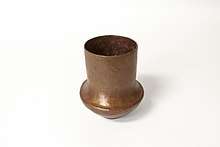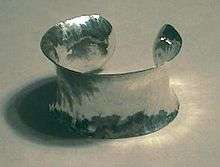Raising (metalworking)


Raising is a metalworking technique whereby sheet metal is depressed in a stump or other solid object by repeated 'courses' of hammering and annealing. A Sheet metal worker is often required to raise, or bump, the work into form from the flat metal, by means of a raising hammer and raising block. The raising block is made from substance giving resistance to the blows.[1]
A modern term is Synclastic raising, the dominant curves of the object being forged are at right angles and move in the same direction; as in a bowl. This results in a surface possessing elliptic geometry.
Anticlastic raising, on the other hand, refers to shaping an object where the dominant axes move in opposite directions; a familiar example of this is a potato chip. This results in a surface possessing hyperbolic geometry.
References
- ↑ Broemel, L. (1918). Sheet metal workers' manual; a complete, practical instruction book on the sheet metal industry, machinery and tools, and related subjects, including the oxy-acetylen welding and cutting process,. Chicago: Drake.
Bibliography
- Finegold, Rupert and William Seitz. Silversmithing. Krause; 1983. ISBN 0-8019-7232-9